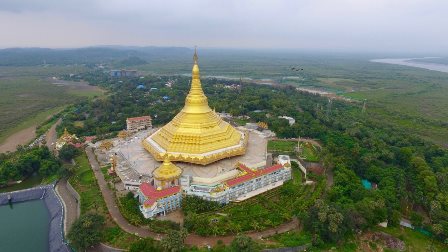by Sayagyi U Goenka
[from the article 'Vedanā Within This Very Body', Vipassana Research Institute newsletter, January 1993]
The entire universe can be experienced within this fathom-long body. The truth of nature is within. Suffering is within. The cause of suffering is within. The way out of suffering is within. Happiness is within.
This is why Vipassana meditators explore the entire mind-matter structure within, this continuously changing phenomenon called ‘I’.
With Vipassana, we experience the subtler realities of this inner world of impermanence within. We gradually come out of ignorance, delusions.
Suffering reduces. Real happiness increases. Impurities get eradicated. The chains of bondage weaken. The door to liberation opens.
The doors of the six sense organs, including the mind, are within the body. These six sense doors come in contact with the world outside.
The universe exists for us only when the sense doors come in contact with the world outside: a visible form in the eye, a sound in the ear, a fragrance in the nose, a taste in tongue, a touch on the body and a thought in the mind.
A visible form, for example, exists for us only when it comes into contact with the eyes. Otherwise it has no existence for us. The entire universe is experienced through these six sense doors. As the Fully Enlightened Super-Scientist said, the entire universe is experienced within this fathom-long body.
To explore the reality within this mind-body structure, the Vipassana meditator works objectively like a scientist.
Set aside all prior beliefs, philosophies, imaginations, and dogmas. To realize the ultimate truth within, work only with the truth that you experience - not blindly accepting another's experience. Accept as truth only what you experience.
How the mind works
You realize this contact produces a vibration - a sensation spreading throughout your body, like striking a bronze vessel at one spot causes the entire vessel to vibrate.
After cognition, perception starts. A part of the mind gives evaluation: the visible form is seen as a male, female, beautiful, ugly.
Sensations, a bio-chemical flow arising in the body, are influenced by this evaluation. If the part of the mind gives evaluation of the object as "good", the sensation is felt as pleasant. If evaluated as "bad", the sensation is unpleasant.
Then the blind reaction. The mind reacts with craving to the pleasant sensations, aversion to unpleasant.
Thus, the Vipassana meditator clearly understands from experience how the four parts of the mind work: consciousness, perception, sensation, and reaction.
Stopping the wheel of misery
The meditator working correctly experiences how this blind reaction to bodily sensations starts a vicious cycle which gathers momentum. This is the wheel of becoming, of misery.
The same process follows with the other sense doors: ear, nose, taste in the tongue, a physical contact with the body, a thought in the mind.
In this way the wheel of becoming continues rotating, gathering intensity with craving and aversion.
The wheel of misery stops rotating with the Vipassana practice of awareness and equanimity to bodily sensations.
Not merely observe sensations, experience the arising, passing away
Of these three, the Buddha gave all importance to anicca because the realisation of the other two easily follows when experiencing deeply the characteristic of impermanence.
Vipassana meditators should not merely objectively observe sensations, but make the effort to clearly experience the arising, passing nature of these sensations (anicca).
Exploring the truth within in this correct way, all subtle truths of nature are realized.
The meditator begins by experiencing gross, solidified, apparent truths. Piercing, penetrating these solidified realities at the level of bodily sensations, the meditator experiences subtler truths. From the grossest to subtler, you reach the stage of the subtlest, ultimate truth.
Learn to observe with equanimity the truth of impermanence; experience the arising, passing bodily sensations. Be liberated from impurities, ignorance, delusions, suffering. Stop the wheel of becoming, of bondage, of misery. Attain real happiness.
May all beings be happy, be peaceful, be liberated.
***

